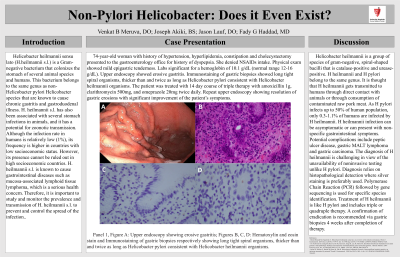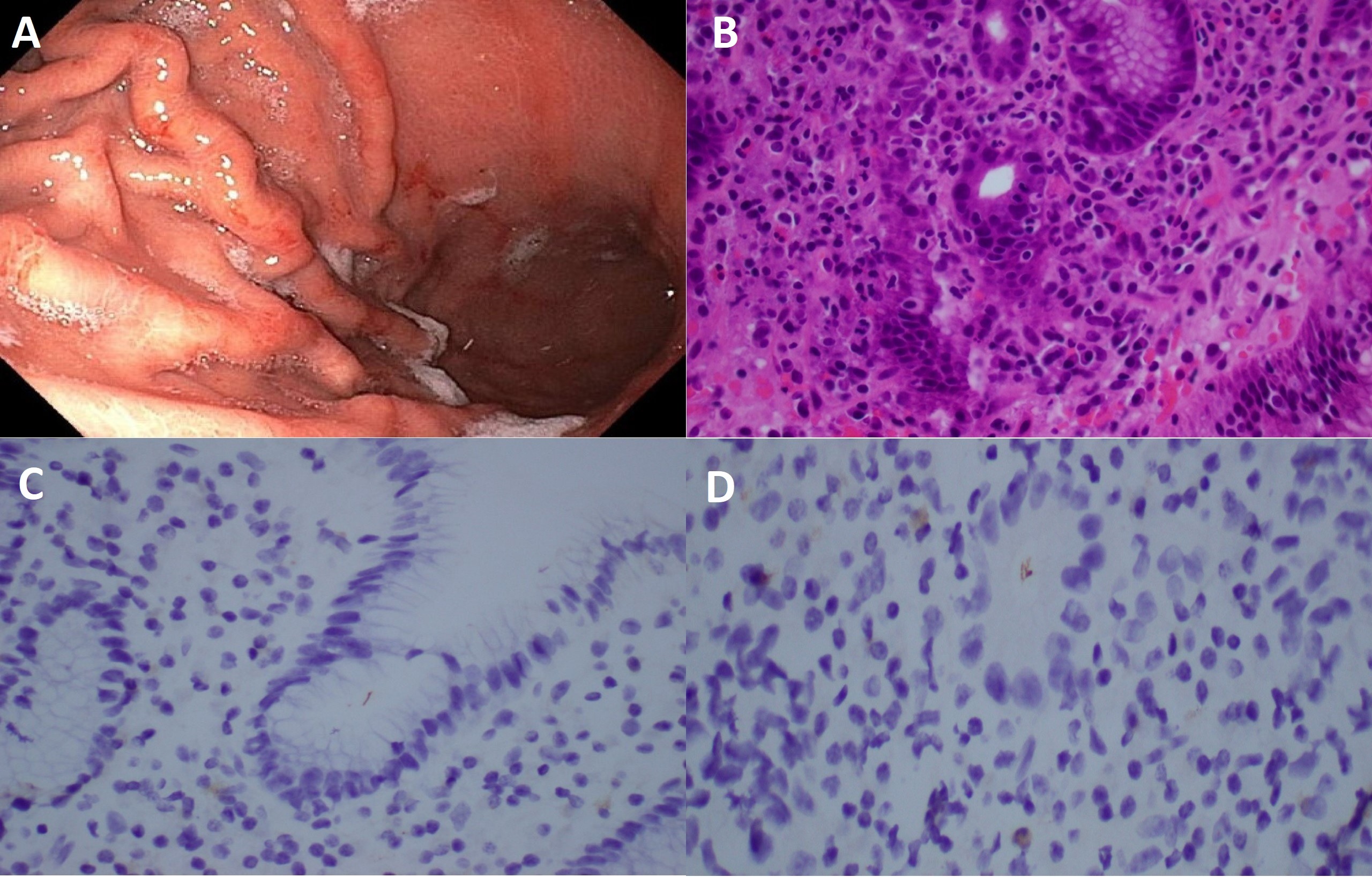Monday Poster Session
Category: Stomach
P2800 - Non-Pylori Helicobacter: Does It Even Exist?
Monday, October 23, 2023
10:30 AM - 4:15 PM PT
Location: Exhibit Hall

Has Audio

Venkat Meruva, DO
University Hospitals Parma Medical Center
Parma, OH
Presenting Author(s)
Venkat Meruva, DO1, Joseph Akiki, BS2, Jason Lauf, DO1, Fady G. Haddad, MD1
1University Hospitals Parma Medical Center, Parma, OH; 2Université Saint Joseph Campus des Sciences Médicales, Beyrouth, Beyrouth, Lebanon
Introduction: Helicobacter pylori is the most common chronic infection in humans and the leading cause of peptic ulcer disease in the world. Non-pylori helicobacter namely H heilmannii exist and can cause gastritis in dogs, cats and pigs. Despite that H heilmannii is well described in animals, it is very rare to cause gastrointestinal (GI) implications in humans, and only few cases are reported in the literature. Herein we report the case of an elderly lady that was diagnosed with symptomatic erosive gastritis secondary to H heilmannii infection.
Case Description/Methods: A 74-year-old woman with history of hypertension, hyperlipidemia, constipation and cholecystectomy presented to the gastroenterology office for few months history of dyspepsia. She denied NSAIDs intake. Physical exam showed mild epigastric tenderness. Labs were significant for a hemoglobin of 10.1 g/dL (normal range 12-16 g/dL). Upper endoscopy showed erosive gastritis. Immunostaining of gastric biopsies showed long tight spiral organisms, thicker than and twice as long as Helicobacter pylori consistent with Helicobacter heilmannii organisms. The patient was treated with a 14 day course of triple therapy consisting of amoxicillin 1g plus clarithromycin 500mg plus omeprazole 20mg twice daily. Repeat upper endoscopy showing resolution of gastric erosions with significant improvement of the patient’s symptoms.
Discussion: Helicobacter heilmannii is a group of species of gram-negative, spiral-shaped bacilli that is catalase-positive and urease-positive. H heilmannii and H pylori belong to the same genus. It is thought that H heilmannii gets transmitted to humans through direct contact with animals or through consumption of contaminated raw pork meat. As H pylori infects up to 50% of human population, only 0.3-1.1% of humans are infected by H heilmannii. H heilmannii infection can be asymptomatic or can present with non-specific gastrointestinal symptoms. Potential complications include peptic ulcer disease, gastric MALT lymphoma and gastric carcinoma. The diagnosis of H heilmannii is challenging in view of the unavailability of noninvasive testing unlike H pylori. Diagnosis relies on histopathological detection where silver staining is preferably used. Polymerase Chain Reaction (PCR) followed by gene sequencing is used for specific species identification. Treatment of H heilmannii is similar to H pylori and includes triple or quadruple therapy. A confirmation of eradication is recommended via gastric biopsies 4 weeks after completion of therapy.

Disclosures:
Venkat Meruva, DO1, Joseph Akiki, BS2, Jason Lauf, DO1, Fady G. Haddad, MD1. P2800 - Non-Pylori Helicobacter: Does It Even Exist?, ACG 2023 Annual Scientific Meeting Abstracts. Vancouver, BC, Canada: American College of Gastroenterology.
1University Hospitals Parma Medical Center, Parma, OH; 2Université Saint Joseph Campus des Sciences Médicales, Beyrouth, Beyrouth, Lebanon
Introduction: Helicobacter pylori is the most common chronic infection in humans and the leading cause of peptic ulcer disease in the world. Non-pylori helicobacter namely H heilmannii exist and can cause gastritis in dogs, cats and pigs. Despite that H heilmannii is well described in animals, it is very rare to cause gastrointestinal (GI) implications in humans, and only few cases are reported in the literature. Herein we report the case of an elderly lady that was diagnosed with symptomatic erosive gastritis secondary to H heilmannii infection.
Case Description/Methods: A 74-year-old woman with history of hypertension, hyperlipidemia, constipation and cholecystectomy presented to the gastroenterology office for few months history of dyspepsia. She denied NSAIDs intake. Physical exam showed mild epigastric tenderness. Labs were significant for a hemoglobin of 10.1 g/dL (normal range 12-16 g/dL). Upper endoscopy showed erosive gastritis. Immunostaining of gastric biopsies showed long tight spiral organisms, thicker than and twice as long as Helicobacter pylori consistent with Helicobacter heilmannii organisms. The patient was treated with a 14 day course of triple therapy consisting of amoxicillin 1g plus clarithromycin 500mg plus omeprazole 20mg twice daily. Repeat upper endoscopy showing resolution of gastric erosions with significant improvement of the patient’s symptoms.
Discussion: Helicobacter heilmannii is a group of species of gram-negative, spiral-shaped bacilli that is catalase-positive and urease-positive. H heilmannii and H pylori belong to the same genus. It is thought that H heilmannii gets transmitted to humans through direct contact with animals or through consumption of contaminated raw pork meat. As H pylori infects up to 50% of human population, only 0.3-1.1% of humans are infected by H heilmannii. H heilmannii infection can be asymptomatic or can present with non-specific gastrointestinal symptoms. Potential complications include peptic ulcer disease, gastric MALT lymphoma and gastric carcinoma. The diagnosis of H heilmannii is challenging in view of the unavailability of noninvasive testing unlike H pylori. Diagnosis relies on histopathological detection where silver staining is preferably used. Polymerase Chain Reaction (PCR) followed by gene sequencing is used for specific species identification. Treatment of H heilmannii is similar to H pylori and includes triple or quadruple therapy. A confirmation of eradication is recommended via gastric biopsies 4 weeks after completion of therapy.

Figure: Panel 1, Figure A: Upper endoscopy showing erosive gastritis; Figures B, C, D: Hematoxylin and eosin stain and Immunostaining of gastric biopsies respectively showing long tight spiral organisms, thicker than and twice as long as Helicobacter pylori consistent with Helicobacter heilmannii organisms
Disclosures:
Venkat Meruva indicated no relevant financial relationships.
Joseph Akiki indicated no relevant financial relationships.
Jason Lauf indicated no relevant financial relationships.
Fady G. Haddad indicated no relevant financial relationships.
Venkat Meruva, DO1, Joseph Akiki, BS2, Jason Lauf, DO1, Fady G. Haddad, MD1. P2800 - Non-Pylori Helicobacter: Does It Even Exist?, ACG 2023 Annual Scientific Meeting Abstracts. Vancouver, BC, Canada: American College of Gastroenterology.
